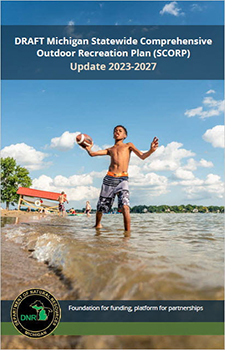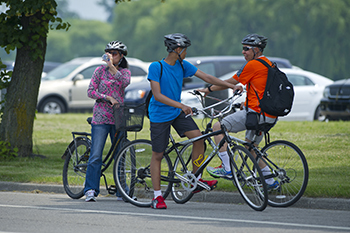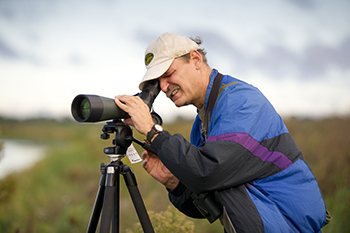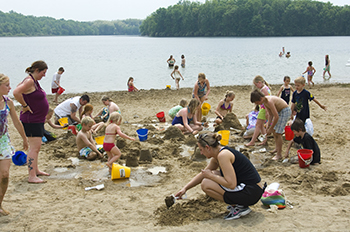New statewide outdoor recreation plan offers wealth of insights
Report to help shape planning for next five years
Michigan’s Statewide Comprehensive Outdoor Recreation Plan is a five-year strategic plan, required to access certain federal grants, that shapes investment by the state of Michigan and local communities in priority outdoor recreation infrastructure, land acquisition and programming.
It is designed to evaluate ongoing and emerging outdoor recreation trends, needs and issues, and to establish priority strategies for achieving outdoor recreation goals. The state and its local outdoor recreation partners use the plan, known as the SCORP, as an ongoing framework and action plan for guiding their outdoor recreation management and policy decisions.

The plan is designed to be broad, serving as a guide for all outdoor recreation activities and communities throughout Michigan. It is flexible to allow for collaboration and strategic partnerships, to be adaptable to changing needs, and to be open to new ideas and strategies.
Requirements
The SCORP process must include opportunity for engagement from all segments of the state’s population and must be comprehensive, in that it specifically:
- Identifies outdoor recreation issues of statewide importance.
- Evaluates public outdoor recreation demand and preferences.
- Evaluates the supply of outdoor recreation resources and facilities.
- Identifies the state’s strategies, priorities and actions for the obligation of its Land and Water Conservation Fund apportionment.
- Contains a wetlands priority component, including a listing of those wetland types that should receive priority for acquisition and consideration of outdoor recreation opportunities associated with wetlands resources.
“The plan not only assesses the current status of recreation in Michigan but also identifies opportunities for the future to address important needs,” said John Pepin, DNR deputy public information officer. “This latest plan also employs some cutting-edge technologies, a significant public survey and explores new correlations between outdoor recreation and health benefits.”
Goals and strategies
The overall goal of the 2023-2027 SCORP is to “ensure that Michigan’s outdoor recreation assets are equitably distributed, developed and managed to provide convenient and welcoming access to the outdoors for healthful, outdoor physical activity; and while sustaining our lands, waters and wildlife for current and future generations, drive broad-based economic and quality-of-life benefits to people and communities.”
|

SCORP strategies to achieve the goal include:
-
Improve collaboration: Outdoor recreation stakeholders collaborate and cooperate to ensure that Michigan’s recreation system meets the needs of residents and visitors.
-
Improve and expand recreational access: Recreation opportunities are connected and accessible to residents and visitors of all backgrounds, abilities, means and geographic locations.
-
Enhance health benefits: Outdoor recreation increases the physical activity and health of Michigan’s residents and visitors.
-
Enhance prosperity: Outdoor recreation advances economic prosperity and supports a high quality of life as well as talent retention in Michigan’s communities.
Public survey
The primary tool to assess various aspects of recreation throughout the state for the plan was the 2021 Michigan Outdoor Recreation Survey.
Survey administrators divided the state into 10 survey regions, based on geography and previously identified “prosperity regions,” which included Detroit Metro, East Central, East, Northeast, Northwest, South Central, Southeast, Southwest, West and Upper Peninsula.
Topics addressed in the survey instrument included recreation participation by activity (frequency and duration), motivations and barriers to participation, recreation opportunities, information seeking and technology, land use strategy (proximity and access to recreation and quality), resources, physical fitness and activity, and demographics.
Additional reports providing significant value included net economic valuation of outdoor recreation and cost of illness saved through recreation.
The goals for the survey were to be representative of Michigan’s general population, repeatable to maintain relevance and enable collection of repeat information on a recurring basis, richer in information collected about activities, frequency and duration, and about motivations and barriers to participation in outdoor recreation, and regional.
“Empowering modeling by state agencies and other stakeholders and partners provides greater context and application of data to support outdoor recreation. It can be the basis for comparative information about outdoor recreation to guide decision making and weigh investments at the state, regional and local levels,” said Brad Garmon, senior strategic advisor and executive director of the Michigan Outdoor Recreation Industry Office. “This is likely only the beginning of additional modeling and analysis using this data that could be undertaken at the state and regional levels.”
|

Survey results
The survey provided the basis for the goals, strategies and recommendations outlined above. Additional insights were gleaned from a follow-up series of diversity-focused regional conversations conducted across the state in partnership with the Michigan Department of Health and Human Services. Both efforts, along with other data collection, were part of a multi-month effort to gather information about recreation demand and resources in Michigan.
Key takeaways from the statewide survey included data showing that:
- Most Michigan residents had participated in some type of outdoor recreation activity within the past year. However, African American or Black residents and those who live in the Detroit Metro area are less likely to engage in recreational activities. Factors such as income, accessibility, age and health may affect one’s ability to participate.
- Outdoor recreation is a healthy, readily available resource with numerous mental and physical benefits. Michiganders, overall, report that participating in outdoor recreation allows them to be close to nature, enjoy psychological benefits and break from their typical routines. Certain motivations, such as practicing culturally meaningful activities and learning new skills, showed significant differences between racial groups. However, mental health benefits are a generally agreed-upon motivator by all.
- Michiganders are generally happy with the availability and quality of recreation locations. However, residents of more densely populated areas are considerably less satisfied with the availability and quality of recreation locations close to their homes.
- Participating in recreation and outdoor activities has many positive effects. Physical health is a primary motivator to engage in recreational activity. However, nearly half of Michigan residents do not engage in the recommended amount of regular physical activity. Promoting outdoor recreation is an easy way to increase and encourage overall health among all Michigan residents.
Health impact of outdoor recreation
The survey method in this SCORP provided the first estimate of the cost of illness savings based on participation in outdoor recreation activity in Michigan.
Based on prior work in Oregon, the “outdoor recreation estimator tool” estimates cost of illness savings for eight primary illnesses including breast cancer, colon cancer, stroke, ischemic heart disease, depression, dementia, diabetes and hypertensive heart disease.
The estimator models the relationship between behavioral changes, changes in physical activity exposure and the resulting health outcomes. Based on this model, the total annual health cost of illness savings in Michigan due to the health impact of outdoor recreation was estimated at $2.8 billion.
|

At the state level, the top 10 activities with the highest annual cost of illness savings for Michigan were:
- Going for a walk on local streets or sidewalks: $927 million.
- Going for a walk on local unpaved trails or paths: $414 million.
- Bicycling on paved streets, paths or sidewalks: $313 million.
- Going for a jog or run on paved streets and sidewalks: $291 million.
- Day hiking on nonlocal, unpaved trails or paths: $199 million.
- Big game hunting: $151 million.
- Off road motorcycling, ATV riding or four-wheeling: $121 million.
- Bicycling on unpaved paths or trails: $113 million.
- Going for a jog or run on unpaved trails or paths: $65 million.
- Swimming at the beach: $44 million.
The results are also be broken out for each of the 10 prosperity regions in Michigan.
Economic value of outdoor recreation in Michigan
This SCORP effort similarly produced the first state economic value of participation in outdoor recreation.
The total net economic value of outdoor recreation in Michigan was estimated at $165 billion.
At the state level, the top 10 most important activities using the net economic value model were:
- Going for a walk on local streets or sidewalks: $26 billion.
- Day hiking on nonlocal, unpaved trails or paths: $18 billion.
- Bicycling on unpaved paths or trails: $16 billion.
- Bicycling on paved streets, paths or sidewalks: $13 billion.
- Wildlife viewing and/or photography (including birding): $12 billion.
- Going for a walk on local, unpaved trails or paths: $11 billion.
- Off road motorcycling, ATV riding or four-wheeling: $9 billion.
- Fishing on lakes or ponds: $8 billion.
- Going for a jog or run on paved streets and sidewalks: $5 billion.
- Big game hunting: $5 billion.
Building on prior work done in Oregon, net economic value of outdoor recreation is modeled based on the economic value of outdoor recreation (or the benefits received by an individual or group who participates in outdoor recreation) using a consumer surplus approach.
Consumer surplus is defined as the economic value of a recreation activity above what must be paid by a person to enjoy it. At the individual level, the net economic value of a recreation activity is measured as the maximum amount an individual is willing to pay to participate in the activity minus the costs incurred in participating.
It is important to note that it is not a measure of direct spending, but an estimation of the maximum value of participating in a specific outdoor activity for an individual.
|

The results are also broken out for each of the 10 prosperity regions in Michigan.
State insights
In addition to these overarching results and modeling efforts, there were several additional highlights to report from the survey at the state level.
Michigan’s overall outdoor recreation participation rate is 95%. Eighty-six percent of Michiganders are involved in trail activities and “other” outdoor activities. Water activities logged 80% participation, wildlife activities 52% and snow activities 40%.
The top 10 activities by frequency were ranked, with the percentages of Michigan residents participating and total annual occasions of participating included.
From this list, the top three, in ascending order, were visiting the beach but not swimming (60% – 49,959,236), going for a walk on local unpaved trails or paths (62% – 380,532,847) and going for a walk on local streets or sidewalks (80% – 1,156,390,531).
The top five motivations for participating in outdoor recreation were ranked with percentages of those agreeing with the reasons included.
The list, reproduced here in ascending order, included to have new experiences (80%), to exercise and be physically challenged (82%), to have time away from normal and life routines (89%), to feel better mentally and emotionally (93%) and to enjoy nature (94%).
In similar fashion, the top five barriers to participating in outdoor recreation were ranked. This list, also in ascending order, included not having enough money for gear, fees and other nontransportation expenses (49%), concern about safety and crime in outdoor recreation areas (49%), recreation areas are poorly maintained (53%), recreation areas are too crowded (60%) and not having time (64%).
Michigander satisfaction with the availability of outdoor recreation, expressed as a percentage of those agreeing, showed 69% were satisfied with recreation availability within a 10-minute walk from their homes; 81% within a 30-minute drive and 82% more than a 30-minute drive away.
Michiganders were satisfied with the quality of outdoor recreation within a 10-minute walk (71%), within a 30-minute drive (81%) and more than a 30-minute drive away (83%).
Comparisons
While changes in methodology between this SCORP and prior plans make direct comparisons impossible, there are certain overall trends that can be identified. For example, the top five outdoor recreation activities in the 2017-2022 SCORP were as follows, in ascending order: visiting nature centers or historic sites, sightseeing and/or driving for pleasure, visiting parks or playgrounds, walking outdoors (including dog walking) and relaxing outdoors.
The top five outdoor recreation activities for the 2022-2027 SCORP, using the new survey methodology, are as follows in ascending order: sightseeing and/or scenic driving for pleasure, visiting parks or playgrounds, visiting the beach but not swimming, going for a walk on local unpaved trails or paths and going for a walk on local streets or sidewalks.
Robust regional comparisons and planning tools can also be made from the survey results. For example, the use of maps to make comparisons provides striking regional and statewide results at glance.
Looking at percentages of participation in water-, snow-, trail-, and wildlife-related activities by region shows trail-related activities are most important in the Upper Peninsula and in northwest Michigan.
In addition, snow-related activities are most important in the Upper Peninsula and the northern two-thirds of the Lower Peninsula, aligning with the parts of the state that receive the most consistent snowfall.
|

Water-related activities scored highest statewide in northwest Michigan, while wildlife-related activities ranked highest in northeast Michigan.
Technological aids
“Several emerging digital tools are showing promise in the effort to understand and track our progress toward meeting the SCORP goals by providing more uniform, real-time insights into recreation demand across ownerships and management,” Garmon said.
For example, as part of the SCORP, the DNR contracted with Cobalt Community Consulting based in Charlotte, Michigan, to run pilot projects looking at several parks and recreation areas, using its “Visitor 360 tool,” which utilizes geofenced cellphone data collected and provided by a third party, ensuring anonymity of all data.
Ten pilot sites were selected to compare the tool’s usefulness in a range of different locations with a variety of characteristics and availability of existing data. Graphs were able to be produced showing visits aggregated weekly, which illustrated peak visitation periods.
Another emerging digital tool that could enable greater collaboration is the Southeast Michigan Council of Governments’ Southeast Michigan Park Finder. The tool shows park locations on a map of the region.
Amenities for each park can be pulled up online by clicking on an icon for the park. Acreage for the park is also shown, as well as which entity owns or manages the park and who to contact about the park.
Links are then available to find the park via Google Maps or to plan a trip to the park using the “Turn off the App – Go Outside tool (TOTAGO).”
Data compiled in the tool can also be filtered to show which parks offer certain features, like water recreation or trails and fitness, and to enable trip planning. Data can be filtered by activity, activity time, distance, difficulty and other parameters.
The map showing the locations of the parks can be zoomed in or out for easier searches. A search blank also allows searching for sites by city or address. The tool is being used in other cities across the country.
Another potential model is the website UPTrails.org, which provides similar data assembly and trip planning guidance by consolidating information from a variety of public recreational trails owners, operators and management agencies into a single site.
“These are examples of collaboration on shared data, with the goal of empowering users with more information to support their outdoor recreation aspirations,” said Scott Whitcomb, who worked on the plan as the director of the DNR’s Office of Public Lands. “Convening agencies and exploring existing and needed investment in data for similar tools and information collection and sharing at the regional and state level could enable these kinds of tools to be used in more jurisdictions across Michigan.”
Find out more about the SCORP and recreation in Michigan.
|
Check out previous Showcasing the DNR stories in our archive at Michigan.gov/DNRStories. To subscribe to upcoming Showcasing articles, sign up for free email delivery at Michigan.gov/DNREmail.
Note to editors: Contact: John Pepin, Showcasing the DNR series editor, 906-226-1352. Accompanying photos and a text-only version of this story are available below for download. Caption information follows. Credit Michigan Department of Natural Resources, unless otherwise noted.
Text-only version of this story.
Beachgoers: Beachgoers enjoy an afternoon at Holly Recreation Area in Oakland County.
Biking: Bikers stop for a break while biking on Belle Isle in Wayne County.
Birding: A birdwatcher adjust his spotting scope at Point Mouille in Wayne County.
Hunting: Two successful rabbit hunters hold up their prize.
Jogging: A jogger enjoys the day at Pinckney State Recreation Area in Washtenaw and Livingston counties.
Kayaking: Two kayakers get ready to head out onto the waters of Lake Ovid at Sleepy Hollow State Park in Clinton County.
|